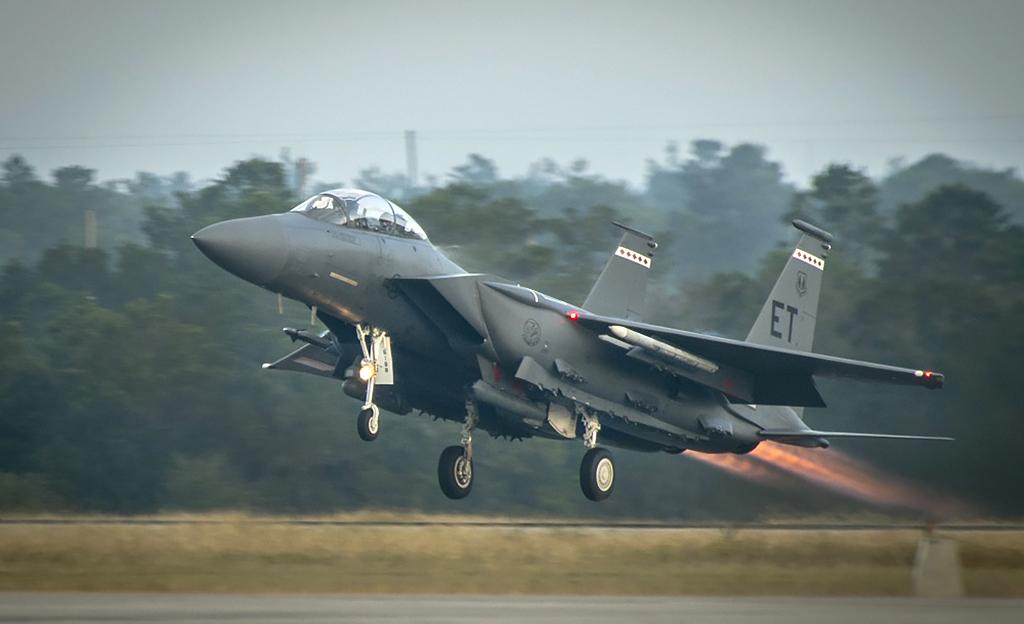
Sukhoi Su-34
Russia is adding electronic warfare capability to the Sukhoi Su-34’s existing Khibiny-10-volt electronic countermeasures suite for escort jamming tasks. It is adding an underfuselage jamming pod with systems that have much more power and a broader frequency range than the basic suite.

Saab JAS 39E/F
Saab’s JAS 39E/F Gripen will be equipped with the Arexis EW system. This is an integrated RWR, intelligence, surveillance and reconnaissance and ECM concept based on ultrawideband digital receivers, DRFM devices, high-power gallium-nitride AESA jammer transmitters and interferometric direction-finding systems. Arexis includes an electronic attack pod aimed at jamming lower frequencies used by anti-stealth radars. The EW system will work with the Gripen E’s Leonardo Raven ES-05 AESA radar. The Gripen can also carry Leonardo’s BriteCloud deployable DRFM jammer, dispensed from a flare cartridge

Boeing EA-18G
The U.S. Navy’s Boeing EA-18G Growler is in line for an EW upgrade, with Raytheon’s ALQ-249 Next-Generation Jammer (NGJ) Increment 1 midband pod replacing ALQ-99 pods on the aircraft beginning in 2022. The pod houses two AESA radars with different transmitters and apertures for standoff jamming of integrated air defense systems. The NGJ will integrate with the Growler’s existing Northrop Grumman ASQ-218 receiver and Raytheon’s APG-73 AESA radar, which has a jamming mode. The F/A-18 E/F Super Hornet has the same AESA, plus Raytheon's ALR-67(V)2 RWR, Harris' ALQ-214(V)4/5 onboard jammer and BAE's ALE-55 fiber-optic towed decoy. The Navy has selected Northrop Grumman and L3 Technologies to work on low-band jammers.

Lockheed Martin F-35
BAE Systems’ ASQ-239 digital offensive and defensive EW system on the F-35 Joint Strike Fighter provides integrated all-aspect, broadband radar warning and geolocation, targeting support and radiofrequency and infrared countermeasures. According to Lockheed Martin, the system has “10 times the effective radiated power of any legacy fighter” for standoff and stand-in jamming and is designed to operate without interfering with the RWR or the Northrop Grumman APG-81 AESA radar that has electronic attack capabilities, including generating false targets, high-power jamming and network attack.

Boeing F-15E
The U.S. Air Force has chosen BAE Systems' Eagle Passive/Active Warning Survivability System (Epawss) to replace the ALQ-135 ECM system that dates back to the 1970s. Epawss is based on BAE’s ALQ-239 Digital Electronic Warfare System, which is being used on Saudi Arabian F-15SAs to provide offensive and defensive EW capability with broadband radar warning and geolocation, 50% more chaff and flare capacity and simultaneous jamming without interfering with the Raytheon APC-82(V)1 and APG-63(V) AESA radars being retrofitted to F-15Es and F-15C/Ds, respectively. Though the Air Force did not request funding for procurement of the Epawss system, Congress has authorized funding to buy the EW kits to upgrade F-15Es and F-15Cs.

Sukhoi Su-57
Russia’s Sukhoi Su-57 integrates radar and EW so that they share some of the many apertures distributed around the stealthy airframe. Developed by the Knirti research institute, the L402 Himalayas ECM system has its own arrays—one in a large sting between the engines—and uses the L-band arrays in the wing leading-edge extensions that are part of the N036 Byelka AESA radar system. In addition to these apertures, the N036, developed by the Tikhomirov Scientific Research Institute of Instrument Design, has the main X-band AESA in the nose and two small side-looking X-band arrays on the forward fuselage.

Sukhoi Su-34
Russia is adding electronic warfare capability to the Sukhoi Su-34’s existing Khibiny-10-volt electronic countermeasures suite for escort jamming tasks. It is adding an underfuselage jamming pod with systems that have much more power and a broader frequency range than the basic suite.

Saab JAS 39E/F
Saab’s JAS 39E/F Gripen will be equipped with the Arexis EW system. This is an integrated RWR, intelligence, surveillance and reconnaissance and ECM concept based on ultrawideband digital receivers, DRFM devices, high-power gallium-nitride AESA jammer transmitters and interferometric direction-finding systems. Arexis includes an electronic attack pod aimed at jamming lower frequencies used by anti-stealth radars. The EW system will work with the Gripen E’s Leonardo Raven ES-05 AESA radar. The Gripen can also carry Leonardo’s BriteCloud deployable DRFM jammer, dispensed from a flare cartridge

Boeing EA-18G
The U.S. Navy’s Boeing EA-18G Growler is in line for an EW upgrade, with Raytheon’s ALQ-249 Next-Generation Jammer (NGJ) Increment 1 midband pod replacing ALQ-99 pods on the aircraft beginning in 2022. The pod houses two AESA radars with different transmitters and apertures for standoff jamming of integrated air defense systems. The NGJ will integrate with the Growler’s existing Northrop Grumman ASQ-218 receiver and Raytheon’s APG-73 AESA radar, which has a jamming mode. The F/A-18 E/F Super Hornet has the same AESA, plus Raytheon's ALR-67(V)2 RWR, Harris' ALQ-214(V)4/5 onboard jammer and BAE's ALE-55 fiber-optic towed decoy. The Navy has selected Northrop Grumman and L3 Technologies to work on low-band jammers.

Lockheed Martin F-35
BAE Systems’ ASQ-239 digital offensive and defensive EW system on the F-35 Joint Strike Fighter provides integrated all-aspect, broadband radar warning and geolocation, targeting support and radiofrequency and infrared countermeasures. According to Lockheed Martin, the system has “10 times the effective radiated power of any legacy fighter” for standoff and stand-in jamming and is designed to operate without interfering with the RWR or the Northrop Grumman APG-81 AESA radar that has electronic attack capabilities, including generating false targets, high-power jamming and network attack.

Boeing F-15E
The U.S. Air Force has chosen BAE Systems' Eagle Passive/Active Warning Survivability System (Epawss) to replace the ALQ-135 ECM system that dates back to the 1970s. Epawss is based on BAE’s ALQ-239 Digital Electronic Warfare System, which is being used on Saudi Arabian F-15SAs to provide offensive and defensive EW capability with broadband radar warning and geolocation, 50% more chaff and flare capacity and simultaneous jamming without interfering with the Raytheon APC-82(V)1 and APG-63(V) AESA radars being retrofitted to F-15Es and F-15C/Ds, respectively. Though the Air Force did not request funding for procurement of the Epawss system, Congress has authorized funding to buy the EW kits to upgrade F-15Es and F-15Cs.

Sukhoi Su-57
Russia’s Sukhoi Su-57 integrates radar and EW so that they share some of the many apertures distributed around the stealthy airframe. Developed by the Knirti research institute, the L402 Himalayas ECM system has its own arrays—one in a large sting between the engines—and uses the L-band arrays in the wing leading-edge extensions that are part of the N036 Byelka AESA radar system. In addition to these apertures, the N036, developed by the Tikhomirov Scientific Research Institute of Instrument Design, has the main X-band AESA in the nose and two small side-looking X-band arrays on the forward fuselage.

Sukhoi Su-34
Russia is adding electronic warfare capability to the Sukhoi Su-34’s existing Khibiny-10-volt electronic countermeasures suite for escort jamming tasks. It is adding an underfuselage jamming pod with systems that have much more power and a broader frequency range than the basic suite.
Advances in commercial electronics are reshaping the electronic warfare (EW) arena. The commercial availability of advanced electronics is driving the proliferation of active, electronically scanned array (AESA) radars with digital architectures and agile waveforms that are harder to defeat, and digital radio-frequency memory (DRFM) devices that enable advanced countermeasures. The result is renewed investment in EW development to bring digital technology to all parts of the system, from radar-warning receivers (RWR) to electronic countermeasures (ECM).






